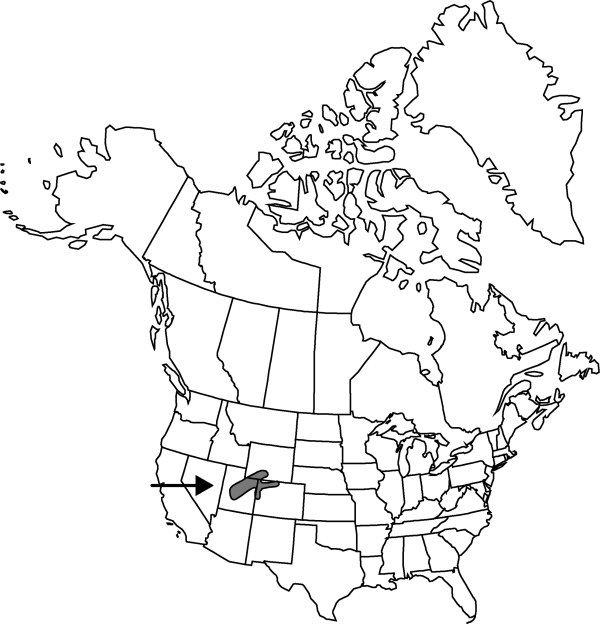Difference between revisions of "Atriplex wolfii var. tenuissima"
Rhodora 102: 422. 2001.
FNA>Volume Importer |
FNA>Volume Importer |
||
| Line 7: | Line 7: | ||
|year=2001 | |year=2001 | ||
}} | }} | ||
| − | |basionyms={{Treatment/ID/ | + | |basionyms={{Treatment/ID/Basionym |
|name=Atriplex tenuissima | |name=Atriplex tenuissima | ||
|authority=A. Nelson | |authority=A. Nelson | ||
| + | |publication_title=Bot. Gaz. | ||
| + | |publication_place=34: 359. 1902 | ||
}} | }} | ||
|synonyms={{Treatment/ID/Synonym | |synonyms={{Treatment/ID/Synonym | ||
| Line 35: | Line 37: | ||
|elevation=1500-2300 m | |elevation=1500-2300 m | ||
|distribution=Colo.;Utah;Wyo. | |distribution=Colo.;Utah;Wyo. | ||
| − | |discussion=<p>Specimens cited by H. M. Hall and F. E. Clements (1923) from central Utah within their concept of <i>Atriplex wolfii</i> in a strict sense have fruiting bracteoles in which the terminal, or apparently terminal, cusp is off-set from the median position, thus appearing to be lateral and lacking a terminal cusp. Other materials cited by them away from the south-central Colorado type locality of <i></i>var.<i> tenuissima</i> bear bracteoles with a similar displacement of the terminal cusp. Hall and Clements placed such specimens within <i>A. wolfii</i>. Bracts of that type are unmatched among the materials of <i></i>var.<i> wolfii</i> in southern Colorado. As interpreted here, the plants belong to <i></i>var.<i> tenuissima</i>.</p> | + | |discussion=<p>Specimens cited by H. M. Hall and F. E. Clements (1923) from central Utah within their concept of <i>Atriplex wolfii</i> in a strict sense have fruiting bracteoles in which the terminal, or apparently terminal, cusp is off-set from the median position, thus appearing to be lateral and lacking a terminal cusp. Other materials cited by them away from the south-central Colorado type locality of <i></i></i>var.<i><i> tenuissima</i> bear bracteoles with a similar displacement of the terminal cusp. Hall and Clements placed such specimens within <i>A. wolfii</i>. Bracts of that type are unmatched among the materials of <i></i></i>var.<i><i> wolfii</i> in southern Colorado. As interpreted here, the plants belong to <i></i></i>var.<i><i> tenuissima</i>.</p> |
|tables= | |tables= | ||
|references= | |references= | ||
| Line 59: | Line 61: | ||
|publication year=2001 | |publication year=2001 | ||
|special status= | |special status= | ||
| − | |source xml=https://jpend@bitbucket.org/aafc-mbb/fna-data-curation.git/src/ | + | |source xml=https://jpend@bitbucket.org/aafc-mbb/fna-data-curation.git/src/f6b125a955440c0872999024f038d74684f65921/coarse_grained_fna_xml/V4/V4_685.xml |
|genus=Atriplex | |genus=Atriplex | ||
|subgenus=Atriplex subg. Obione | |subgenus=Atriplex subg. Obione | ||
Revision as of 20:02, 24 September 2019
Stems erect, intricately branched, 0.5–3 dm. Leaves: proximalmost blade linear, 4–20 × 2–3 mm, distalmost blade bracteate, sometimes ovate or ovate-lanceolate, densely grayish scurfy. Staminate flowers confined to a few distal axils. Fruiting bracteoles ovate or ovate-lanceolate in profile, (1.8–)2.3–2.7 × 1.5–2.1 mm, distal lobe typically larger and broader than lateral lobes, terminal tooth typically much largest or with this apparently displaced laterally.
Phenology: Flowering summer–fall.
Habitat: Plants of saline bottoms, often in margins of marshy areas with salt grass, greasewood, and seepweed
Elevation: 1500-2300 m
Distribution

Colo., Utah, Wyo.
Discussion
Specimens cited by H. M. Hall and F. E. Clements (1923) from central Utah within their concept of Atriplex wolfii in a strict sense have fruiting bracteoles in which the terminal, or apparently terminal, cusp is off-set from the median position, thus appearing to be lateral and lacking a terminal cusp. Other materials cited by them away from the south-central Colorado type locality of var. tenuissima bear bracteoles with a similar displacement of the terminal cusp. Hall and Clements placed such specimens within A. wolfii. Bracts of that type are unmatched among the materials of var. wolfii in southern Colorado. As interpreted here, the plants belong to var. tenuissima.
Selected References
None.